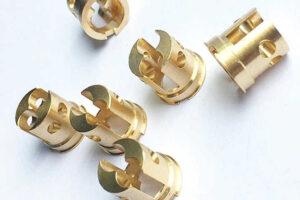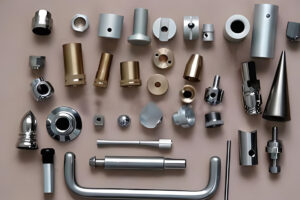Bronze Fabrication

Prior to commencing the fabrication of bronze components, it is recommended to consult this comprehensive guide.
This guide encompasses all the essential information to assist you in selecting the most suitable bronze material, determining its applications, and choosing the appropriate surface finish, among other considerations.
Therefore, before embarking on your next bronze fabrication project, make sure to peruse this guide thoroughly.
Advantages of Bronze for Fabrication
Bronze possesses numerous qualities that render it an ideal choice for various sheet metal fabrication processes.
Whether you intend to cut, shape, or weld bronze, its inherent features make it compatible with virtually all manufacturing techniques.
- Bronze, being a ductile alloy, exhibits exceptional formability and a lower susceptibility to disintegration under stress when compared to cast iron.
- Typically composed of copper and tin, bronze lacks magnetic properties unless blended with magnetic materials like iron.
- When struck, bronze does not ignite by sparking, ensuring safety when working with potentially explosive or flammable substances.
- Fabricating bronze results in high dimensional precision and yields a remarkable surface finish.
- With a higher density than steel, bronze can be made less dense by incorporating elements like silicon and aluminum.
- The fabrication of bronze as a copper alloy is relatively straightforward, and it boasts a lower melting point compared to iron or steel, typically around 950°C depending on the alloying constituents.
- Bell bronze, featuring a copper-tin ratio of 4:1, offers exceptional resonance, making it an excellent choice for crafting bells.
- Oxidation on bronze surfaces is superficial, forming a protective layer of copper oxide or carbonate that guards against atmospheric and seawater-induced corrosion.
- Certain bronzes, such as bearing bronze containing up to 8% lead, exhibit low friction characteristics.
- The excellent conductivity of copper, present as an alloying element in bronze, enables it to function well as an electrical and thermal conductor.
- In terms of cost-effectiveness, copper alloys like bronze outperform nickel-based alloys.
Varieties of Bronze in Fabrication
Various bronze alloys, comprising copper, tin, and additional alloying elements like zinc, silicon, and manganese, find applications in metal fabrication. Here are some common options:
Aluminum Bronze
Containing 6% copper and 12% aluminum, aluminum bronze may include small quantities of manganese, iron, silicon, and/or nickel.
This type of bronze is suitable for custom fabrication of parts requiring:
– High resistance to corrosion, particularly in saline environments.
– High tensile strength.
– Resistance to tarnishing.
Cupronickel
This type of bronze contains nickel in varying concentrations, ranging from 2% to as high as 30%.
It is suitable for fabricating parts that necessitate:
– Exceptional stability under extreme temperatures.
– Resistance to elemental corrosion.
– High durability.
Manganese Bronze
With a manganese content of 3% and supplemented by elements like iron, zinc, aluminum, and copper.
Parts crafted from this bronze should exhibit distinctive properties such as:
– Deformability under stress rather than fracturing.
– Shock resistance.
– Corrosion resistance.
Phosphor Bronze
Comprising approximately 0.35% phosphorus, along with 88% copper and around 11% tin, this bronze type boasts enhanced stiffness and wear resistance, making it ideal for electrical fasteners and perforated sheets.
Suitable for sheet metal parts that require:
– High yield strength.
– Fine grain structure.
– Low coefficient of friction.
– Compatibility with arc welding, soldering, and brazing.
– High durability.
Silicon Bronze
Featuring copper, silicon, zinc as primary alloying elements, sometimes supplemented by iron, manganese, and tin.
Key properties that render it suitable for sheet metal fabrication parts include:
– Smooth flow during processing.
– Impressive surface finish.
– High strength.
– Enhanced corrosion resistance.
Bismuth Bronze
Containing bismuth levels between one and six percent, similar in function to leaded bronze.
Unique characteristics of this bronze for sheet metal fabrication comprise:
– High malleability.
– Excellent heat conduction.
– Outstanding corrosion resistance.
– Easily polished.
Uses of Bronze Fabrication Parts
Bronze fabrication encompasses various processes like cutting and forming to create complete parts for diverse applications. Some common uses of fabricated bronze parts are as follows:
i. Boat construction utilizes bronze for fabricating propellers and underwater components due to its exceptional corrosion resistance and toughness.
ii. The superior resonance qualities of bronze make it a popular choice for manufacturing bells, cymbals, and certain musical instruments.
iii. Bronze’s high strength and non-sparking properties make it ideal for tool production, including mallets, hammers, and wrenches.
iv. Its robust nature allows bronze to be used in the fabrication of springs, bushings, connectors, and transmission bearings.
v. The toughness, low friction, and wear-resistant attributes of bronze find frequent application in machine and automobile bearings.
vi. For crafting aesthetically pleasing structural components, bronze is favored for its durability and minimal maintenance requirements.
Surface Finishes for Bronze Fabrication

Surface finishes play a crucial role in bronze fabrication by enhancing surface protection and improving overall appearance. There are several finishes that can be applied, with some of the more common options including:
Metal Plating
Bronze surfaces can be plated with metals like nickel and chrome using electrical or electroless methods. This plating not only enhances resistance to atmospheric corrosion and wear but also improves the aesthetic appeal of the surface.
Clear Coating
Due to its rich and colorful finish, bronze stands out even without additional processing. Clear coating is used to preserve this natural allure while providing protection against environmental elements, without compromising the surface qualities.
Design Considerations for Bronze Fabrication
When working with bronze sheet metal, it’s important to consider design aspects to optimize cost and quality. While the fabrication process itself may not be overly complex, attention to detail can help control production costs without sacrificing the final outcome.
Design for Manufacturability (DFM)
In bronze fabrication, designing for manufacturability is key to cost efficiency. One important aspect of DFM is incorporating bend reliefs when performing sharp bends on bronze to prevent crack formation, particularly as bronze has a tendency to work harden in such scenarios.
Alloy Selection
Selecting the right bronze alloy is crucial to avoid issues like work hardening, especially during processes involving shear stress like bending. Opting for a bronze alloy with low work hardening propensity can help maintain the material’s integrity.
Limitations of Bronze Fabrication
While bronze is a versatile material, it does have limitations, such as:
– Most bronze alloys tend to work harden during cold working, leading to deformation.
– Exposure of uncoated bronze to the elements can result in patina formation, affecting the surface appearance.
– Bronze is vulnerable to chemical corrosion, particularly from sulfides and chlorides.
Expertise in Bronze Fabrication
At metalfabricationchina, we specialize in delivering high-quality, bespoke bronze parts tailored to your specific requirements. Whether simple or intricate designs, we ensure top-notch fabrication of bronze parts.
Our services include:
– Precision cutting of bronze sheet metal through laser cutting, plasma cutting, and Waterjet cutting.
– Forming bronze into custom shapes and sizes via bending, stamping, or punching.
– Assembling bronze parts using various methods like welding and riveting.
– Applying appropriate surface finishes to enhance the aesthetics and durability of fabricated bronze parts.
Conclusion
In summary, successful fabrication of bronze sheet metal involves careful selection of bronze grade and fabrication techniques based on part complexity and desired outcomes. For more information, please visit our website for additional resources.”
Bronze – Source: Wikipedia
